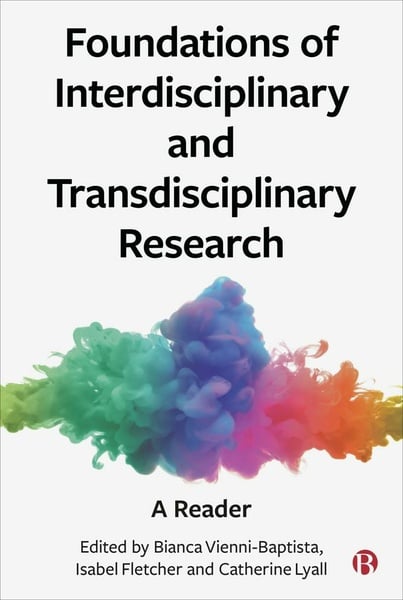Harnessing Collective Expertise: The Advantages Of Interdisciplinary And Transdisciplinary Work

Table of Contents
The world faces increasingly complex challenges – climate change, global pandemics, economic instability – that defy simple solutions. Traditional, single-discipline approaches often fall short, lacking the breadth and depth necessary to address these multifaceted problems. This is where the power of interdisciplinary and transdisciplinary work comes into play. By combining diverse perspectives and expertise, interdisciplinary and transdisciplinary collaborations unlock enhanced creativity, improved problem-solving, and more effective solutions. This article explores the key advantages of embracing these collaborative approaches.
Enhanced Creativity and Innovation through Diverse Perspectives
Combining diverse viewpoints is the cornerstone of interdisciplinary and transdisciplinary research. The synergistic effect of bringing together individuals from different academic backgrounds, professional experiences, and cultural lenses fosters a rich environment for creative breakthroughs.
- Breaking down silos and encouraging cross-pollination of ideas: Interdisciplinary teams transcend the limitations of working within isolated disciplinary silos. This cross-pollination allows for the free exchange of ideas and methods, leading to unexpected and innovative connections.
- Challenging assumptions and established paradigms within individual disciplines: The inherent biases and assumptions within any single discipline can be challenged and refined through exposure to contrasting perspectives. This critical examination generates new insights and pathways for innovation.
- Generating novel approaches to problem-solving that wouldn't emerge from a single perspective: The ability to draw on a broader range of tools, techniques, and theoretical frameworks results in more comprehensive and original solutions to complex problems.
- Examples of successful interdisciplinary and transdisciplinary projects: The development of effective public health strategies during a pandemic, the creation of sustainable urban planning solutions, and advancements in medical technology all benefit greatly from collaborative interdisciplinary and transdisciplinary efforts.
Improved Problem-Solving Capabilities
Complex problems rarely fall neatly into the domain of a single discipline. Interdisciplinary and transdisciplinary work provides the framework to comprehensively analyze and address these multifaceted challenges.
- Addressing complex problems requiring multiple disciplinary approaches: From climate change modeling to designing effective educational programs, tackling these challenges demands input from diverse fields like engineering, sociology, economics, and environmental science.
- Identifying blind spots and biases within individual disciplines: Working collaboratively highlights the limitations of individual perspectives. By openly acknowledging and addressing potential biases, teams can achieve a more balanced and comprehensive understanding of the problem.
- Developing more robust and sustainable solutions: Diverse perspectives contribute to the development of more holistic and resilient solutions, anticipating potential challenges and vulnerabilities that might be missed by a single discipline.
- Improved critical thinking and evaluation of solutions due to diverse perspectives: The rigorous examination of proposed solutions through multiple lenses strengthens their validity and ensures their effectiveness.
Increased Efficiency and Resource Optimization
Collaborative work isn't just about innovation; it's also about optimizing resources and increasing efficiency. Interdisciplinary and transdisciplinary projects streamline workflows and minimize redundancy.
- Sharing resources and expertise: Team members contribute their specialized knowledge and resources, reducing the need for duplication of effort.
- Avoiding duplication of effort: By leveraging the existing expertise within the team, resources are allocated more effectively, saving both time and money.
- Faster project completion times due to parallel work streams: Teams can work concurrently on different aspects of the project, accelerating the overall timeline.
- Cost savings through efficient resource allocation: The efficient use of resources leads to significant cost savings, making collaborative projects a fiscally responsible approach.
Better Communication and Collaboration Skills
Engaging in interdisciplinary and transdisciplinary work is a valuable professional development opportunity. Collaboration enhances essential skills for success in today's interconnected world.
- Improved communication across diverse professional backgrounds: The necessity of clear and effective communication fosters the development of strong interpersonal skills.
- Enhanced teamwork and collaboration skills: Working effectively within a diverse team enhances collaborative problem-solving and conflict-resolution abilities.
- Development of negotiation and conflict-resolution skills: Navigating diverse viewpoints requires strong negotiation and conflict-resolution skills.
- Building stronger professional networks: Interdisciplinary collaborations build valuable professional networks, fostering long-term collaborations and mentorship opportunities.
Addressing Complex Real-World Challenges
Interdisciplinary and transdisciplinary approaches are not just beneficial for academic research; they are crucial for addressing some of humanity's most pressing challenges.
- Climate change mitigation and adaptation strategies: Developing effective strategies requires insights from climatology, engineering, economics, and social sciences.
- Sustainable development initiatives: Designing sustainable solutions demands a multifaceted approach, integrating environmental, economic, and social considerations.
- Public health crises: Effective responses to public health emergencies require the combined expertise of epidemiologists, healthcare professionals, public policy experts, and communication specialists.
- Technological advancements with social impact: The ethical and societal implications of technological advancements necessitate interdisciplinary collaboration between engineers, ethicists, and social scientists.
Unlocking the Power of Interdisciplinary and Transdisciplinary Collaboration
In conclusion, the advantages of interdisciplinary and transdisciplinary work are undeniable. From sparking creativity and improving problem-solving capabilities to increasing efficiency and fostering stronger communication, these collaborative approaches are essential for tackling complex global challenges. By embracing the power of collective expertise, we can unlock innovative and effective solutions to create a better future. Start harnessing the power of collective expertise by seeking out interdisciplinary and transdisciplinary projects today! Embrace the advantages of interdisciplinary and transdisciplinary work for impactful, innovative results.

Featured Posts
-
 Will A Canadian Tire Hudsons Bay Partnership Succeed Analysis And Predictions
May 19, 2025
Will A Canadian Tire Hudsons Bay Partnership Succeed Analysis And Predictions
May 19, 2025 -
 Dr John Delony Why His Approach To Uncomfortable Topics Resonates
May 19, 2025
Dr John Delony Why His Approach To Uncomfortable Topics Resonates
May 19, 2025 -
 Marcus And Martinus Dublin Concert The Academy Show Announced
May 19, 2025
Marcus And Martinus Dublin Concert The Academy Show Announced
May 19, 2025 -
 Johnny Mathis Announces Retirement Final Tour Dates Revealed
May 19, 2025
Johnny Mathis Announces Retirement Final Tour Dates Revealed
May 19, 2025 -
 Finding Lipscomb In March Madness History And Future Prospects
May 19, 2025
Finding Lipscomb In March Madness History And Future Prospects
May 19, 2025
